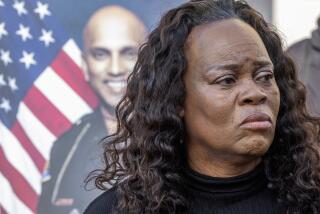Officers Linked to Death of Teen
Two Los Angeles police officers sought to cover up their contact with a 16-year-old gang member who was shot to death on the border of a rival gang’s territory just minutes after the officers released him from their patrol car, according to a district attorney’s review of the case.
Neither officer, one of whom was accused of dropping off the same youth in rival gang territory as punishment a month earlier, documented the encounter with the victim on the day he was killed.
“It appears, based on this investigation, that [the officers] intentionally withheld information from the homicide detectives, internal affairs investigators and their chain of command,” wrote Deputy Dist. Atty. Laura L. Laesecke, who investigated the officers as part of the Rampart scandal. “Not only does their lie obstruct justice, but it also calls into question the veracity of the rest of their ... statements” about the case.
Ultimately, Laesecke concluded that the officers could not be prosecuted for obstructing justice because the best evidence against them came from so-called compelled statements in which they were ordered to cooperate with authorities or face termination from the Los Angeles Police Department. Such statements cannot be used in court against those who made them.
Additionally, Laesecke wrote, the statute of limitations on such a charge had expired. Both officers, Mario Rios and Michael Montoya, deny any wrongdoing and remain on the job.
Montoya, now assigned to the community relations office in Northeast Division, seemed resigned to the criticism he and other officers have faced in the wake of the Rampart scandal.
“This is not the first bad thing that’s been said about me. They’re not true,” Montoya said in a recent interview. “But what can be done about it?”
Montoya and Rios, now assigned to Southeast Division, were charged administratively by LAPD officials with making false statements about the case during an internal affairs investigation.
They were cleared of wrongdoing after they presented a declaration from a retired homicide detective who said he recalled Montoya mentioning that he knew the victim as a police informant, but did not remember whether the officer acknowledged having any contact with him on the day he was killed.
The detective refused to testify at the officers’ hearing. In a recent interview with The Times, he declined to comment at length, saying only that he could not recall what the officers told him about their interaction with Eric Vega, known on the streets as “Baby Happy.”
The incident, which was documented along with more than 80 other cases recently rejected for prosecution by the district attorney, came to light as part of the investigation into the Rampart scandal, launched in 1999 following the admissions and allegations of corrupt ex-cop Rafael Perez.
The Vega case itself, however, was never mentioned by Perez. Instead, investigators came upon it as they looked into allegations of officer misconduct in another Rampart case.
According to police reports, Montoya and Rios were working an “observation post” in the 1200 block of South Lake Street on Nov. 5, 1996, looking for suspicious gang or drug activity, when they spotted Eva Garcia dealing drugs. Based on their observations, other officers from the Rampart anti-gang CRASH unit swooped in and arrested her.
What the police reports do not state -- and what officers admitted years later during compelled interviews with detectives -- was that while Garcia was being arrested, Vega also was handcuffed and put in the back of Montoya and Rios’ squad car.
The officers said later that Vega was not arrested but actually was a police informant who wanted to pass on information to them. He was handcuffed, the officers said, only so that his fellow gang members would not become suspicious of his cooperation.
After a few minutes of driving around with Vega in the car, the officers said, they concluded that Vega did not have any significant information and asked him where he wanted to be dropped off. Vega, they said, asked to be let out near a gang hangout known as El Castillo, where his mother was staying. The officers said they dropped him off there.
Moments later, at 4:39 p.m., Montoya and Rios received a radio call about a shooting. Within a minute, they were at the scene -- the first officers to arrive. The victim, they discovered, was Vega.
The killing occurred on the border of a rival gang’s territory and was a couple of blocks from where the officers allegedly released Vega. Witnesses later implicated a rival gang member in the killing, but no arrests have been made.
Montoya said he told a sergeant and the lead homicide detective that night about their contact with the shooting victim. Like the detective, the sergeant said in a recent interview that he had no recollection of any such conversation.
Unaware of Vega’s death, his mother and girlfriend went to South Lake Street looking for him about 6 p.m. that day. A neighborhood resident told them Vega had been arrested. They then went to the Rampart station, but were told there was no record of his arrest.
The next day Vega’s mother went to Juvenile Hall to find her son, but there was no record of him being there either. When she returned home, she later told police, she learned that her son had been killed shortly after he was taken away by officers the previous day.
Suspicious of the timing, Vega’s mother and his girlfriend returned to the police station and claimed that officers were somehow connected to the youth’s death. It was at that point that Vega’s girlfriend also said she was with her boyfriend about a month earlier when Rios and another officer put Vega in the back of their squad car and drove off.
She said she saw her boyfriend about two hours later, his shirt torn and a frightened look on his face. She said Vega told her the officers gave him a choice: get dropped off in territory of the Mara Salvatrucha gang or the Rockwood gang, both rivals of his 18th Street gang. He said he chose Rockwood.
After Vega got out of the car, he allegedly said, the officers shouted to two of his rivals that Vega was from 18th Street. He told his girlfriend that the gang members chased him and managed to rip his shirt but did not catch him.
In her analysis of the events surrounding Vega’s murder, prosecutor Laesecke raised a series of questions about the officers’ accounts.
If they dropped off Vega at El Castillo, where his mother was, why did he then walk from there toward Pico Boulevard, a well-known border between his gang’s territory and that of a rival? And how was it that he found himself in a life-threatening struggle “within five minutes” of being dropped off by the police?
The prosecutor also noted that the two officers did not document their contact with Vega in any of the reports they generated that day, a violation of department policy. “Montoya and Rios completed their [daily report], Eva Garcia’s arrest report and their report as first officers on the murder scene after Vega was killed and, therefore, were aware at the time the reports were written of the significance of their contact with him,” she wrote. “Nevertheless, they omitted his name and any reference to any contact with him from each of those reports.”
Finally, the prosecutor was skeptical of the officers’ claim that they told a supervisor.
For one thing, Laesecke noted, there is no mention of the officers’ contact with Vega in the homicide report prepared by Det. John Curiel. And on the day after Vega’s killing, in a tape-recorded interview with the victim’s girlfriend, Curiel can be heard asking the young woman for basic information, such as the location of the arrest, a description of the officers involved and the reason for the arrest.
“If [Curiel] was already aware of Montoya’s and Rios’ involvement, it seems logical that he would have also asked Garcia some questions based on the information given to him by the officers or at least tried to reassure her that the officers were not involved in Vega’s death,” she continued.
Gary Wigodsky, an alternate public defender who has been specializing in Rampart cases, said the officers’ conduct described in the district attorney’s memo is “outrageous.” He noted that most of the officers interviewed during the investigation had very little recollection of the incident. “That’s a telltale sign,” he said. “You know something fishy happened when they can’t remember anything.”
More to Read
Sign up for Essential California
The most important California stories and recommendations in your inbox every morning.
You may occasionally receive promotional content from the Los Angeles Times.











